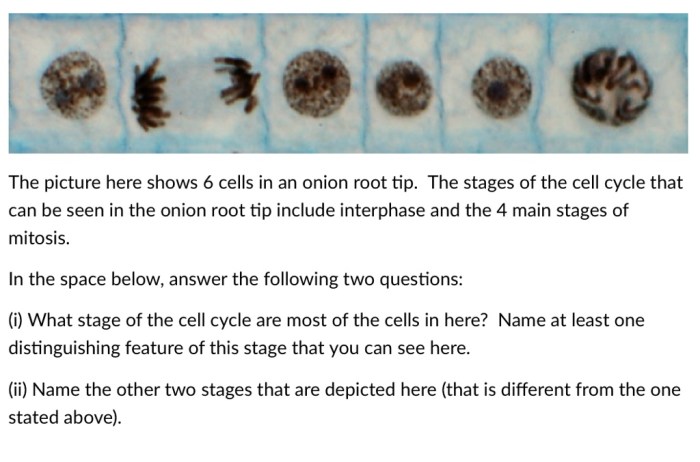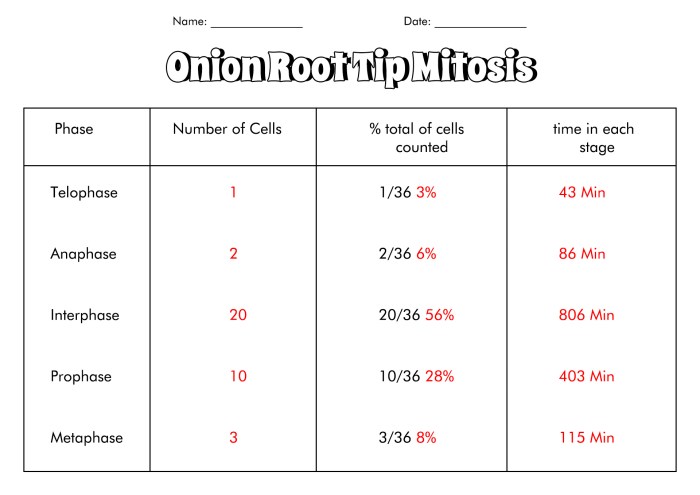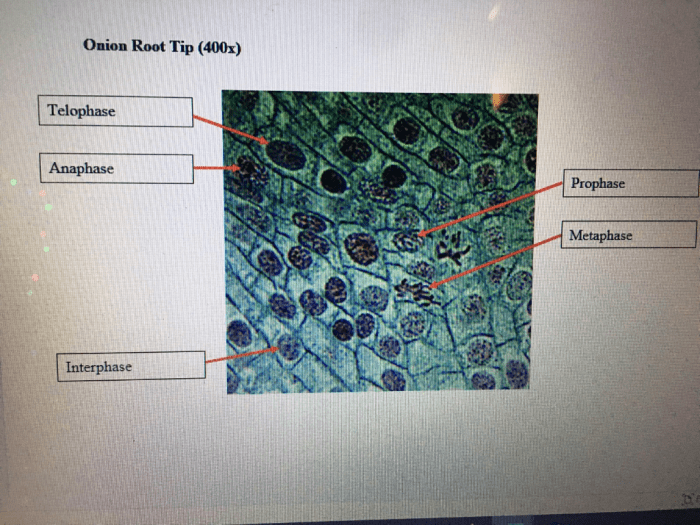Embark on a microscopic adventure with our onion root tip answer key! Discover the fascinating stages of mitosis, unravel the intricate cell structures, and witness the pivotal role of cell division in plant growth. Get ready to delve into the captivating world of cellular biology!
Uncover the secrets of cell division by exploring the distinct phases of mitosis, from the intricate dance of chromosomes in prophase to the final separation of sister chromatids in telophase. Delve into the diverse cell structures, each playing a vital role in the life of an onion root tip cell, from the protective cell wall to the enigmatic nucleolus.
Onion Root Tip Cell Division

The onion root tip is a valuable resource for studying cell division because it contains a high number of actively dividing cells. By examining the root tip under a microscope, we can observe the different stages of mitosis in real-time.
Prophase
Prophase is the first and longest stage of mitosis. During prophase, the chromatin condenses into visible chromosomes, and the nuclear envelope breaks down. The centrosomes, which are responsible for organizing the spindle fibers, begin to move to opposite poles of the cell.
Metaphase
In metaphase, the chromosomes line up along the equator of the cell. The spindle fibers attach to the chromosomes and begin to pull them apart.
If you’re stuck on an onion root tip answer key, don’t fret! Head over to our comprehensive guide on ap lang 2020 mcq answers for a detailed breakdown. With our expert tips and insights, you’ll master onion root tip analysis in no time.
Anaphase
During anaphase, the sister chromatids of each chromosome separate and move to opposite poles of the cell. The spindle fibers shorten, pulling the chromosomes apart.
Telophase
In telophase, the chromosomes reach the poles of the cell and begin to decondense. The nuclear envelope reforms around each set of chromosomes, and the spindle fibers disappear. Cytokinesis, the division of the cytoplasm, then occurs, resulting in the formation of two daughter cells.
| Stage | Key Characteristics |
|---|---|
| Prophase | Chromatin condenses into visible chromosomes, nuclear envelope breaks down, centrosomes move to opposite poles of the cell. |
| Metaphase | Chromosomes line up along the equator of the cell, spindle fibers attach to the chromosomes and begin to pull them apart. |
| Anaphase | Sister chromatids of each chromosome separate and move to opposite poles of the cell, spindle fibers shorten, pulling the chromosomes apart. |
| Telophase | Chromosomes reach the poles of the cell and begin to decondense, nuclear envelope reforms around each set of chromosomes, spindle fibers disappear, cytokinesis occurs. |
Onion Root Tip Cell Structure: Onion Root Tip Answer Key

An onion root tip cell is a complex structure with various organelles and structures that perform specific functions. Let’s explore the different cell structures and their roles.
Cell Wall
The cell wall is a rigid structure that surrounds the cell membrane. It provides support, protection, and shape to the cell. In plant cells, the cell wall is primarily composed of cellulose, a strong and flexible polysaccharide.
Cytoplasm
The cytoplasm is the jelly-like substance that fills the cell. It contains various organelles, including the nucleus, and is where most of the cell’s metabolic activities take place.
Nucleus
The nucleus is a membrane-bound organelle that contains the cell’s genetic material, DNA. It is the control center of the cell, directing cellular activities and regulating gene expression.
Nucleolus
The nucleolus is a small, dense structure within the nucleus. It is involved in the synthesis of ribosomes, which are responsible for protein synthesis.
Labeled Diagram of an Onion Root Tip Cell
[Insert a labeled diagram of an onion root tip cell here, clearly identifying the structures mentioned above.]
Onion Root Tip Cell Cycle

The cell cycle is a fundamental process that drives cell growth and division. It is a continuous and tightly regulated sequence of events that leads to the production of new cells.
Onion root tip cells are frequently used to study the cell cycle because they are easily accessible and have a high rate of cell division.
Phases of the Cell Cycle
The cell cycle consists of four distinct phases: G1, S, G2, and M. Each phase has specific events that occur and is crucial for the proper functioning of the cell.
- G1 Phase (Gap 1 Phase):During the G1 phase, the cell grows and prepares for DNA replication. It synthesizes proteins and organelles and increases in size.
- S Phase (Synthesis Phase):In the S phase, the cell replicates its DNA, resulting in two identical copies of each chromosome. This process is essential for ensuring that each new cell receives a complete set of genetic material.
- G2 Phase (Gap 2 Phase):The G2 phase is a period of growth and preparation for cell division. During this phase, the cell checks for DNA damage and repairs any errors. It also synthesizes proteins and organelles necessary for mitosis.
- M Phase (Mitosis Phase):The M phase is the actual process of cell division. It involves the separation of chromosomes and the formation of two daughter cells. Mitosis is a complex process that occurs in several stages, including prophase, metaphase, anaphase, and telophase.
After completing the M phase, the cell cycle begins again with the G1 phase.
Flowchart of the Cell Cycle
The following flowchart illustrates the progression of the cell cycle:

Onion Root Tip Mitosis and Plant Growth

Mitosis is a crucial process in plant growth, contributing significantly to the development of new tissues and organs. It plays an essential role in maintaining the health and survival of plants, as well as ensuring their successful reproduction.
Mitosis and Tissue Development
Mitosis allows plants to produce new cells, which are essential for the growth and development of new tissues. As plants grow, they require additional cells to increase their size and complexity. Mitosis ensures a continuous supply of new cells, enabling the plant to expand its root system, produce new leaves, and develop reproductive structures.
Mitosis and Organ Formation, Onion root tip answer key
Mitosis is not only involved in tissue development but also in the formation of new organs. During plant growth, specific groups of cells undergo mitosis to form specialized structures, such as flowers, fruits, and seeds. These organs are essential for the plant’s reproductive success and overall survival.
Mitosis and Plant Survival
Mitosis plays a vital role in plant survival by allowing for cell repair and replacement. As plants encounter environmental stresses or damage, mitosis enables the production of new cells to replace damaged or lost ones. This process helps maintain tissue integrity and ensures the plant’s ability to continue growing and functioning properly.
Mitosis and Plant Reproduction
Mitosis is essential for plant reproduction. In flowering plants, mitosis produces the cells that give rise to pollen and egg cells. These reproductive cells undergo meiosis to create gametes, which combine during fertilization to form a new plant. Mitosis also contributes to the development of seeds, which contain the embryo and nutrients necessary for germination and the growth of a new plant.
Common Queries
What is the significance of the onion root tip in studying mitosis?
Onion root tips are an ideal material for studying mitosis because they exhibit a high rate of cell division and have large, easily observable chromosomes.
How many stages are there in mitosis?
There are four main stages in mitosis: prophase, metaphase, anaphase, and telophase.
What is the role of the cell wall in an onion root tip cell?
The cell wall provides structural support and protection for the cell.

